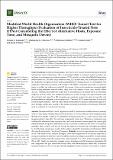| dc.description.abstract | The standard World Health Organization (WHO) tunnel test is a reliable laboratory bioassay used for “free-flying” testing of insecticide-treated nets (ITNs) bio-efficacy where mosquitoes pass through a ITN sample to reach a live animal bait. Multiple parameters (i.e., bait, exposure time, and mosquito density) may affect the outcomes measured in tunnel tests. Therefore, a comparison was conducted of alternative hosts, exposure time, and lower mosquito density against the current gold standard test (100 mosquitoes, animal bait, and 12-h exposure) as outlined in the WHO ITN evaluation guideline. This was done with the aim to make the tunnel test cheaper and with higher throughput to meet the large sample sizes needed for bio-efficacy durability monitoring of chlorfenapyr ITNs that must be evaluated in “free-flying” bioassays. Methods: A series of experiments were conducted in the WHO tunnel test to evaluate the impact of the following factors on bio-efficacy endpoints of mosquito mortality at 24-h (M24) and 72-h (M72) and blood-feeding success (BFS): (1) baits (rabbit, membrane, human arm); (2) exposure time in the tunnel (1 h vs. 12 h); and (3) mosquito density (50 vs. 100). Finally, an alternative bioassay using a membrane with 50 mosquitoes (membrane-50) was compared to the gold standard bioassay (rabbit with 100 mosquitoes, rabbit-100). Pyrethroid-resistant Anopheles arabiensis and pyrethroid susceptible Anopheles gambiae were used to evaluate Interceptor® and Interceptor® G2 ITNs. Results: Using a human arm as bait gave a very different BFS, which impacted measurements of M24 and M72. The same trends in M24, M72 and BFS were observed for both Interceptor® ITN and Interceptor® G2 unwashed and washed 20 times measured using the gold standard WHO tunnel test (rabbit-100) or rabbit with 50 mosquitoes (rabbit-50). M24, M72 and BFS were not statistically different when either 50 or 100 mosquitoes were used with rabbit bait in the tunnel bioassay for either the susceptible or resistant strains. No systematic difference was observed between rabbit-50 and rabbit-100 in the agreement by the Bland and Altman method (B&A). The mean difference was 4.54% (−22.54–31.62) in BFS and 1.71% (−28.71–32.12) in M72 for rabbit-50 versus rabbit-100. Similar M24, M72 and lower BFS was measured by membrane-50 compared to rabbit-100. No systematic difference was observed in the agreement between membrane-50 and rabbit-100, by B&A. The mean difference was 9.06% (−11.42–29.64) for BSF and −5.44% (−50.3–39.45) for M72. Both membrane-50, rabbit-50 and rabbit-100 predicted the superiority of Interceptor® G2 over Interceptor® ITN for the resistant strain on M72. Conclusion: These results demonstrate that WHO tunnel tests using rabbit bait may be run with 50 mosquitoes to increase sample sizes needed for bio-efficacy durability monitoring of ITNs in “free-flying” bioassays. Using a membrane feeder with 50 mosquitoes is a potential replacement for the WHO tunnel bioassay with animal bait if control blood feeding rates can be improved to 50% because blood feeding impacts mosquito survival after exposure to insecticides. | en_US |

